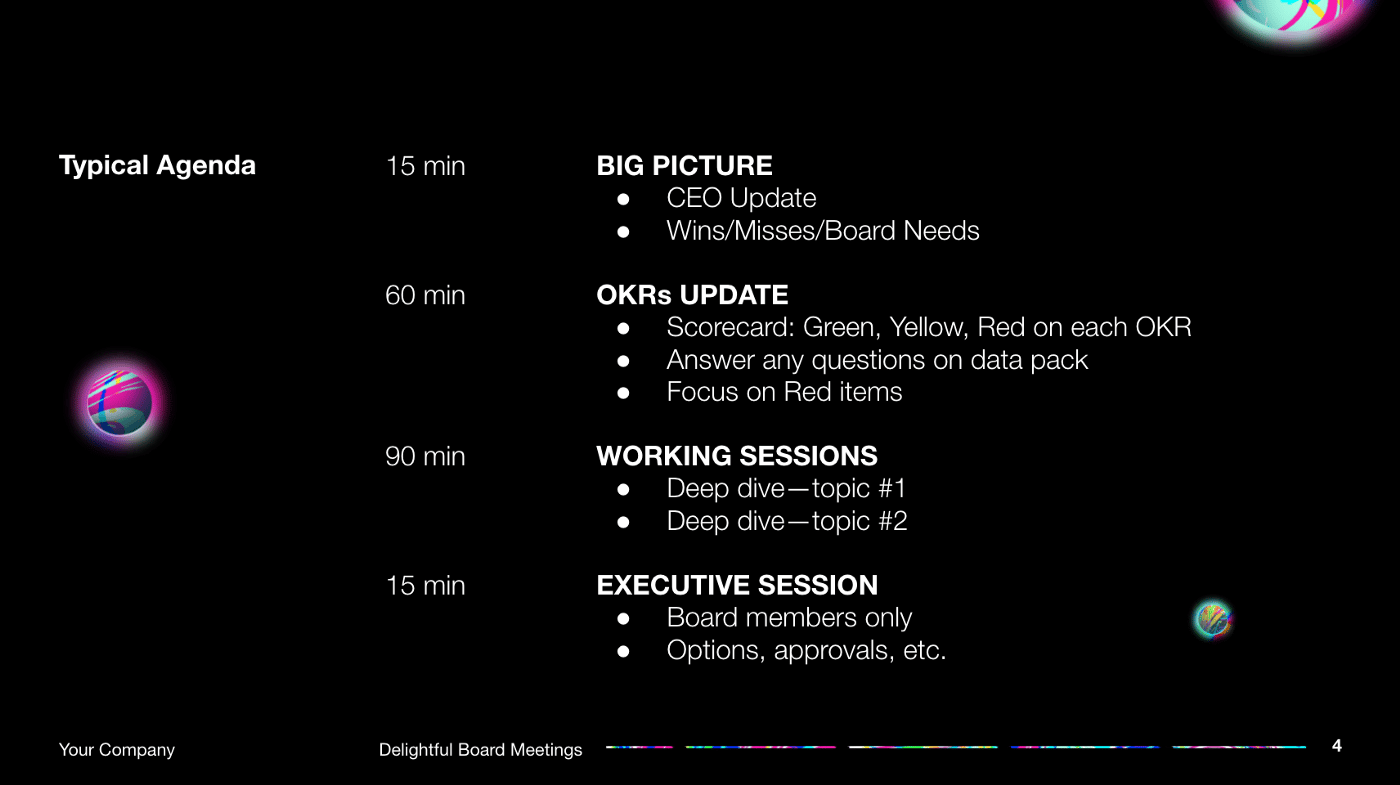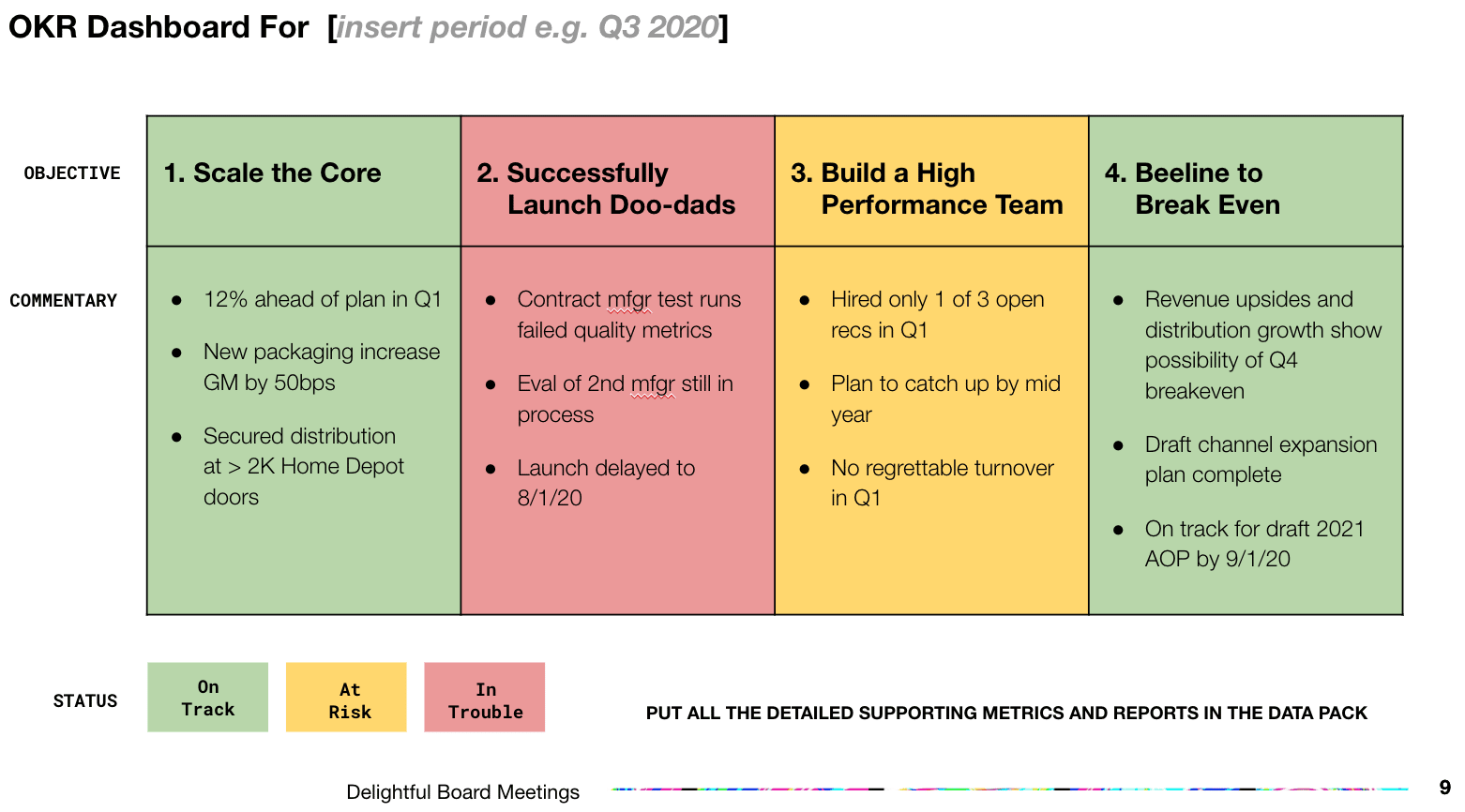Delightful Board Meetings
A recipe for effective and enjoyable startup board meetings
James Joaquin |

The folklore of bad board meetings at venture-backed startups is too strong to ignore.
Desultory meetings run by sleep-deprived CEOs pulling all-nighters to get the board slides done. Frantic product teams racing to cobble together an innovation demo for the just-conjured roadmap. And let’s not forget cranky, unprepared investors asking minutia questions about slide #4 that will be fully answered on slide #7.
What if you could flip all that into a truly delightful collaboration between founders and investors that help the business stay true to its purpose and (hopefully) achieve great success?
Recent events pushing leadership teams to all-remote sessions makes it all the more important to pick the right strategy and structure for board effectiveness.
The Basics
Between my time as a startup CEO to becoming a venture investor / board member, I’ve seen the transformative power of running and being a part of delightful board meetings. And given the brainpower in the room, any board’s goal should be constructive engagement around strategic matters, not getting into the minutia of project by project updates.
Below are a few of the basics to keep in mind that, in and of themselves, should shift the balance of your board meetings for the better.
Scheduling Matters
We have all been at the two hour BOD meeting that runs way over time. Start by setting aside at least three hours instead, enabling you to dig in strategically and preserve time for the mundane but necessary housekeeping at the end (e.g. options, approvals, etc.). Earlier stage startups need board meetings every six to eight weeks. As companies mature they typically move to quarterly— I recommend the third Tuesday after closing the quarter (4x a year). This will give you time to report on quarterly numbers, and give the BOD a consistent anchor point for data and performance.
Preparation: “Data Pack” Pre-Read & BOD Questions
The efficacy of BOD meetings are directly connected to the quality of the material and preparation of board members. Start by separating a “data pack” deck from your board deck, and send both as a pre-read for the BOD. The data pack should contain relevant information and tactical updates (from detailed financials to market research and market share reporting) that could otherwise eat up your entire board meeting. Send the material to the BOD at least 48 hours in advance of your meeting, and require them to send any questions in by 10pm the night before. This will be a positive forcing function for your board members to come prepared. [For large boards, I also suggest setting up 1:1 pre-brief calls with Directors.] You can set aside some time in each board meeting to address any questions on the data pack, and more importantly assume that your investors are up to speed on all that foundational information to set the stage for deep dive discussions.
The Meeting: The Deck & OKRs as Scaffolding
With the bulk of your metrics reporting culled into your data pack, your board deck can now focus on the critical few strategic issues the company is facing. We recommend building your board meeting agenda around company OKRs, where you can use a green/yellow/red scorecard as a simple gauge of performance. [For a lean, mean effective guide to setting company OKRs, read our series here.] For a typical three hour board meeting, we recommend the following time allocation:

Do your best to summarize the company state of the union in one slide for the “big picture” including wins, misses, and board needs. For the OKR update, start with a restatement of the company-wide OKRs, then follow that with a dashboard of how we’re doing on those year-to-date and commentary and color for the BOD to understand why.


For the working sessions, set up a key strategic question or challenge for the business that you want your board’s brainpower on (and provide adequate supporting material that Directors can digest in advance and come prepared to discuss and debate). It’s not uncommon for a deep dive to match a red OKR area or a key fork in the road where the company needs to deploy resources wisely. Time permitting, you may be able to work in a second deep dive.
For the executive session: If your team is large enough to have exec members presenting in the board meeting, it’s good hygiene to end with a short closed session for Directors only. Here you can cover matters like a general check-in with the CEO on the team and business, legal housekeeping, option grant approvals, and board calendar.
You’ve Got Scale
As your business and board dynamics mature, there are a number of growth-stage board tactics worth considering (including those listed in this post, reflecting on my experience as a Director on the board of Seventh Generation before their acquisition by Unilever):
- Recruit for board diversity, as it will simply deliver better outcomes
- Schedule one offsite meeting per year focused on long-term strategic vision
- Schedule one “walking around” meeting per year where the board meets with each team/department in the company
- Create real working committees and rotate membership every two years to cross-train skills
- Practice reflection and feedback, both to and from the CEO
We’ve created a BOD meeting template that you’re free to steal and make your own. I hope this helps deliver less stress and more delight to your board.



